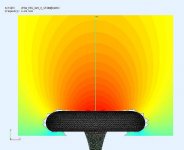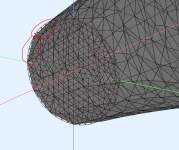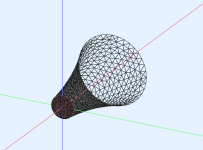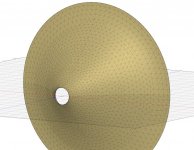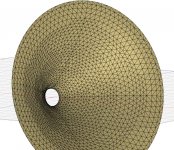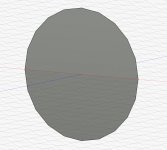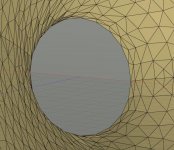True enough if one is trying to duplicate the performance of antiques. But so much more is known today that simply throwing it out because it isn't "original" just does not make sense. It's like trying to compare an old Ferrari with a new one. Doing that on performance grounds is simply a non-issue - there is no comparison.
Maybe, but I am quite sure that many would prefer to drive the old Ferrari
The BEM sims make no assumption about the wavefront or how the curvature was derived. The wavefront shape certainly changes through the frequency range. It was interesting to see how that changes with the variants (rollbacks, merges, stretches, etc). It will be easy to see how they perform when the data is published.
Last edited:
Maybe, but I am quite sure that many would prefer to drive the old Ferrari
Not me that's for sure!!
A little off topic, but not so much. I was struck recently by a Car and Driver study where they brought back a classic and compared it to a new release. The classic was an Acura NSX from the early 2000's (one of my favorite cars) against a new Civic RS (I owned a Civic SI, so I knew the car.) In terms of performance the reviewers had to admit that the Civic was the better car!! The costs of the two were night and day different of course no matter how you look at it. That shows how much modern technology can change the game.
Last edited:
The BEM sims make no assumption about the wavefront or how the curvature was derived. The wavefront shape certainly changes through the frequency range.
That is correct, of course, and modern numerical techniques have advanced the state-of-the-art considerably. But if you look at the thread https://www.diyaudio.com/forums/multi-way/338806-acoustic-horn-design-easy-ath4-new-post.html you will see that these techniques have already been used to find the "optimum", so it's not a problem waiting to be solved.
There is not a single solution, of course, any more than there is a single music variety. People all like different things.
But if one stands back and takes an analytic look at sound reproduction, like say Floyd Toole, Sean Olive, or myself, they can come up with a set of criteria which are deemed to be the most responsible for quality sound reproduction. In this case there is a single optimal solution to meeting these criteria.
Add in people's preference and everything goes out the window.
But if one stands back and takes an analytic look at sound reproduction, like say Floyd Toole, Sean Olive, or myself, they can come up with a set of criteria which are deemed to be the most responsible for quality sound reproduction. In this case there is a single optimal solution to meeting these criteria.
Add in people's preference and everything goes out the window.
There is not a single solution, of course, any more than there is a single music variety. People all like different things.
But if one stands back and takes an analytic look at sound reproduction, like say Floyd Toole, Sean Olive, or myself, they can come up with a set of criteria which are deemed to be the most responsible for quality sound reproduction. In this case there is a single optimal solution to meeting these criteria.
Add in people's preference and everything goes out the window.
I would like to point out once again that this work is part of my hobby. Just because some people believe that they have found the optimal solution, I can still follow other paths. The programming of the OS waveguides cost me only a few hours. These are completely trivial and simple formulas. We also simulated these horns and then excluded them after reviewing the results for further processing. So you can come to other conclusions. If these OS waveguides are so extraordinarily good, why do you have to emphasize that on every occasion over and over again with that particular emphasis?
The problem I have with "optimum" is that I don't know how peaked (kurtosis) the solution distribution is. Maybe I'm happy being a little to the left or right because I did not optimize for a just a single parameter.
My "optimum" is never in the subjective, i.e. "happy", it's objective. Subjective and objective are apples and oranges. And there is no reason that the distribution is not "normal". Toole finds that it is fairly normal when properly taken, with a fairly narrow STD to boot!
I think that there can be more than one optimum based on ones expectation of reproduction. Some like transparency, clarity and image and others opt more for spaciousness, ambiance and ASW. I design to image and clarity in a loudspeaker, spaciousness is in the room/loudspeaker interface.
Last edited:
Not me that's for sure!!
A little off topic, but not so much. I was struck recently by a Car and Driver study where they brought back a classic and compared it to a new release. The classic was an Acura NSX from the early 2000's (one of my favorite cars) against a new Civic RS (I owned a Civic SI, so I knew the car.) In terms of performance the reviewers had to admit that the Civic was the better car!! The costs of the two were night and day different of course no matter how you look at it. That shows how much modern technology can change the game.
This is not the place for in-depth reflections on cars and inherent progress in the automotive industry. The latter has hardly been the case in the last 10-15 years.
The 'best Honda ever' isn't a car, but the Honda Super Cub.
The Honda Super Cub series is a series of light motorcycles produced continuously by Honda from 1958. With production numbers surpassing 60 million in 2008, 87 million in 2014, and 100 million in 2017, the Super Cub is the most produced motor vehicle in history.
Honda's engineering masterpiece is this:

Complexity causes confusion and makes comparisons between up-to-date SOTA technology and that of one or a few decades ago difficult.
The NSX is undeniably a technological highlight in car history, but it is very hard to compare it with today's cars.
No matter how good, the NSX is far from perfect.
The almost 60 year old engine shown above is about perfect, even by today's standards.
That said and OT:
Although a beloved car, it is precisely the oem 'meep meep' horn in the Civic (shown on the right in the image below) that is being replaced by many owners with a 'more serious' specimen.
A logical and obvious upgrade is the snail horn that is mounted in the Civic's bigger brother: the Accord.
But some opt for even bigger and louder aftermarket snail horns as visible on the left.
An externally hosted image should be here but it was not working when we last tested it.
Last edited:
Cornu spiral
Hi,
a new article about the Cornu (Euler) spiral is online.
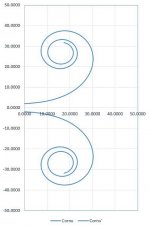
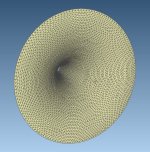
Spiral Functions for Horns – The Cornu Spiral – Sphericalhorns
Hi,
a new article about the Cornu (Euler) spiral is online.


Spiral Functions for Horns – The Cornu Spiral – Sphericalhorns
An article about my favourite spiral function is online: the Sici spiral.
Spiral Functions for Horns – The Sici Spiral – Sphericalhorns
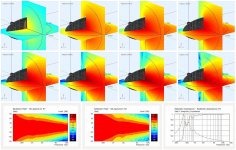
Spiral Functions for Horns – The Sici Spiral – Sphericalhorns

Hello,
a new post about my JMLC inspired horn calculator is online:
JMLC Inspired Horn Calculator – Sphericalhorns
A corresponding calculator is also available in the download section of my page.
Merry X-mas!
a new post about my JMLC inspired horn calculator is online:
JMLC Inspired Horn Calculator – Sphericalhorns
A corresponding calculator is also available in the download section of my page.
Merry X-mas!
holes in BEM mesh
Hi Docali, I was reading through your article "BEM simulation for freestanding horns". You mentioned to use different mesh sizes for the different components. But how do you prevent holes in the model if 2 adjacent elements have different mesh sizes? In the next image I try to illustrate the issue. You can see the driver (fine mesh) and the inner horn (coarser mesh). When I zoom in you can see the holes in the model where driver and inner horn are connected (marked in red). edit: I have meshed driver and inner horn in gmsh separately.
Hi Docali, I was reading through your article "BEM simulation for freestanding horns". You mentioned to use different mesh sizes for the different components. But how do you prevent holes in the model if 2 adjacent elements have different mesh sizes? In the next image I try to illustrate the issue. You can see the driver (fine mesh) and the inner horn (coarser mesh). When I zoom in you can see the holes in the model where driver and inner horn are connected (marked in red). edit: I have meshed driver and inner horn in gmsh separately.
Attachments
Last edited:
Hi Megaet,
the article you reference to was written by DonVK. He is a member of this forum and you may contact him here.
But in his article DrBA Calculator and BEM Simulation – Sphericalhorns he mentioned the following:
"A new flat disc driver membrane was created in FreeCad [6] that exactly matched the throat mesh."
HTH,
Bernd
the article you reference to was written by DonVK. He is a member of this forum and you may contact him here.
But in his article DrBA Calculator and BEM Simulation – Sphericalhorns he mentioned the following:
"A new flat disc driver membrane was created in FreeCad [6] that exactly matched the throat mesh."
HTH,
Bernd
I think Don does it by drawing a polyline manually to match at the vertices.
If you have Fusion 360 or a similar CAD package you can create a surface patch over the open end of the horn mesh and export that to stl and mesh it in gmsh at a higher resolution.
I export the mesh as an stl from ABEC in the Options menu (need to solve the mesh first) insert that into Fusion (changing the units to Metres because ABEC uses metres as the file unit).
Convert the mesh to a Brep surface. Fusion needs to be in direct modelling to do this so right click on Document settings in the tree and select do not capture design history. Then in the solid model tab right click on the mesh body and choose mesh to brep command.
Then go to surface tab and create a patch click in the open end of the waveguide until the profile is highlighted and you will get a surface that matches.
Turn everything else off and export to stl. Depending on which side you created the patch from may mean that you have to swap the normals in ABEC to have the diaphragm pointing the right way.
If you have Fusion 360 or a similar CAD package you can create a surface patch over the open end of the horn mesh and export that to stl and mesh it in gmsh at a higher resolution.
I export the mesh as an stl from ABEC in the Options menu (need to solve the mesh first) insert that into Fusion (changing the units to Metres because ABEC uses metres as the file unit).
Convert the mesh to a Brep surface. Fusion needs to be in direct modelling to do this so right click on Document settings in the tree and select do not capture design history. Then in the solid model tab right click on the mesh body and choose mesh to brep command.
Then go to surface tab and create a patch click in the open end of the waveguide until the profile is highlighted and you will get a surface that matches.
Turn everything else off and export to stl. Depending on which side you created the patch from may mean that you have to swap the normals in ABEC to have the diaphragm pointing the right way.
Attachments
- Home
- Loudspeakers
- Multi-Way
- DrBA horns at sphericalhorns.net
